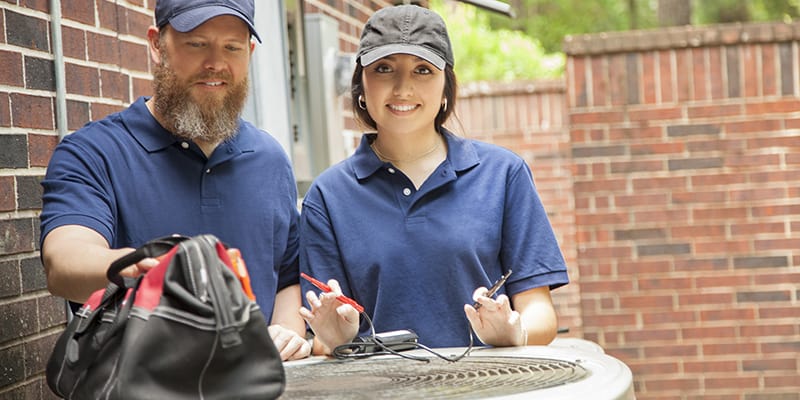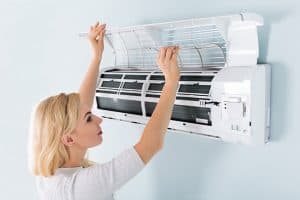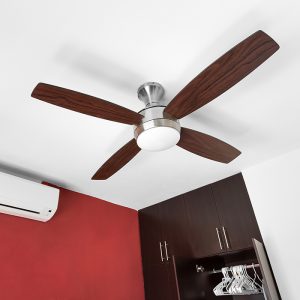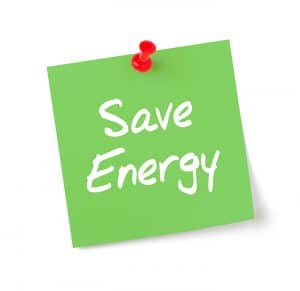Check out our expert tips and resources to keep your home clean, safe, and efficient!
HVAC Tips for Fall
Transitioning your HVAC system from summer functions to fall and winter is not as simple as just turning the AC off. You should ease both your home and your air conditioning system into the next season. Here are some tips to help you make the switch as smooth as possible:
Use Fans and Open Windows
Once the weather starts to mellow out, you can at least turn the air conditioning unit to a lower setting. Once you do that, start using your ceiling fans a little bit more and opening windows. Not only does it take some of the burden off your air conditioner, it allows your house to air out and stay fresh.
Close the Blinds
Although this is a great summer tactic to take strain off of your air conditioner, it works for just about any season. Approximately 25% of your home’s hot and cold air is lost through small cracks and holes, which means curtains and blinds are great energy savers. They not only keep the sun and heat out in the summer, they keep the cool in when you need them to.
Turn the AC Off at Night
During the Fall, not only is the weather during the day getting more mild, the nights are becoming even cooler. This is a great time of year to save energy by turning your AC off at night. Open a window and leave a few fans on in the house to circulate the cool night air and you’ll wake up in a home that feels fresh and cool without breaking the bank before autumn fully sets in.
Keep in mind on warmer nights, it will take more energy to cool your home once the AC unit is turned back on than it would have, had you left your air conditioner on the entire time. Check the weather before going to sleep and rely on your AC unit for when the temperature does spike back up.
Schedule Maintenance
Though you may not think it, your HVAC services need preventative maintenance at least twice every year. This is the perfect transitional time to have your system inspected. Not only should you have your AC inspected, but your furnace needs a checkup as well. It’s just as important to repair any damage done over the summer months as it is to prepare your heating system for the cold of winter.
Sources:
“4 Tips to Help You Transition Your HVAC System from Summer to Fall” Pioneer HVAC
“Running Your Air Conditioner in the Fall” BR McGinty
End of Summer Tips
By the end of the summer, your air conditioner has gone through quite a workout. If your air conditioner was not serviced in the spring, there could be a buildup of debris in the condenser, among other things; this can cause your air conditioner to run less efficiently. Regular tune-ups keep your AC running at peak efficiency, which can save you money on your energy bills. Here are some tips to help you out before the summer’s end:
Change Your Air Filter
Changing your air filter is one of the easiest things that you can do to maintain your AC. This is not only important for air quality but also the life of your air conditioning unit. A clogged air filter can cause your system to work harder. This uses more energy and may even cause the unit to breakdown, both of which are costly. Make sure that you are using the correct AC filter for your unit and replacing the filter on your central air system at least once every other month.
Clean Coils and Drain Line
Blocked coils on the outside unit can also cause your AC to work harder than it needs to, which can lead to issues that need to be repaired. For central units, you can use a broom and your garden hose to remove debris. Similarly, you want to make sure that your AC’s condensate drain line is clean to prevent any malfunctioning. Use boiling water to clear any small blockages.
Remove Any Obstructions from the Unit
Check to make sure that the outdoor unit is not blocked by plants or other debris that might have grown or accumulated over the summer. If you have hedges or other plants that you use to hide the outdoor unit, make sure that they are at least a foot away from the unit to avoid obstructions. Indoor units should also be free of obstructions like curtains or drapes.
Program Your Thermostat
If you have a central system, you should use your thermostat to slightly raise the temperature during the day when you are away from the house and then lower the temperature when you return. This helps reduce any unnecessary strain on your AC, while also helping you save on energy costs. Some thermostats can be controlled from your Smartphone, allowing you to make these adjustments even when you’re not home. Some smart thermostats will even learn your schedule and habits over time, making the process more automated.
Get a Tune-up or Maintenance Services from a Professional
To keep your central AC unit running smoothly throughout the year, it is important to get an annual tune-up from an HVAC professional who will check and clean the filter, test the system, and charge the unit with refrigerant. This is best completed in the spring before you start using it for the summer, but it is never too late for a tune-up.
Sources:
“3 Reasons to Schedule AC Maintenance Before Summer Ends” A Quality HVAC
“5 AC Maintenance Tips for the End of the Summer” Air Conditioning Engineers
Mistakes You’re Making with Your Air Conditioner
You Aren’t Changing or Cleaning Your AC Filters
At a minimum, you should be changing the filter on your central AC unit once every three months—and as often as once a month if your system is running all the time.
Neglect this chore, and a dirty filter can lead to poor air flow or freezing up of your unit’s evaporator coil. A filthy filter could add 5% to 15% to your AC bill, and will shorten the lifespan of your whole system.
You’re Not Having Your System Serviced Annually
You can look up online video tutorials about cleaning your AC unit’s coils and fins—necessary maintenance operations that keep your system up and running efficiently. You could also bring in a pro to service your system once a year.
You Don’t Have a Programmable Thermostat
A programmable thermostat can save you hundreds on your annual AC bill by automatically raising the temp at those times of day when you’re at work or away from home.
You’re Setting Your Thermostat Too Low
Research shows the human body is capable of adapting to hot or cool temperatures pretty quickly—like within a week or two. When you consider you’ll cut up to 3% off your AC bill for every degree you raise the temperature—it’s worth sweating through that adjustment period and setting your thermostat somewhere in the high 70s.
You’re Not Taking Full Advantage of Fans
Any type of fan, but especially ceiling fans, can help keep cool air circulating throughout your home. That removes some of the burden from your AC system.
Your Thermostat and/or Vents Are Poorly Positioned
If the sun or a nearby lamp blasts your thermostat for big chunks of the day, that could throw off its readings and cause it to crank your AC even though your place is pleasantly cool. Blocking AC vents with furniture or curtains can also limit air circulation. You want to be sure your AC vents are unobstructed.
You’re Cooling Empty Rooms
If AC vents are open in every room of your house, you’re chilling a lot of real estate that may not be in use on a day-to-day basis. Walk around and close those AC vents that open onto unoccupied rooms. Also, closing closet doors ensures those spaces aren’t swallowing your cold air.
You Don’t Have Blinds or Curtains
Bright sunlight is your AC system’s nemesis. By closing blinds and sliding curtains to block the sun’s rays, you’ll also shield your space from the sun’s heat.
Source: Markham Heid, “8 Big Mistakes You’re Making With Your Air Conditioner”, Time Health
Ways to Save Energy in the Office
Updating hardware and gear
Having old computers, phones, and any other type of electronics will significantly damage your energy saving plan. This isn’t just an occasion for the environment to get cleaner and healthier but also for the office to get the hardware it always wanted or needed.
Don’t leave anything running
One of the worst practices that happen in a ton of office spaces is the fact that people leave their electronics open when they leave work. Employees should be asked to make sure that everything is turned off before they leave the office. This includes not just their work computers and appliances like printers or fax machines, but also things like the coffee maker or TV if you have a recreation room for instance.
Consider laptops
Laptops use way less energy than desktops and provide the same hardware capabilities. You can get laptops that are just as powerful, if not stronger, than your current desktop setup. This also allows for more mobility and overall increased productivity.
Consider green power
If you intend to aim big, this is as big as it gets when it comes to saving energy. Keep in mind that this can also be a very lucrative move for the company considering the shrinkage in electricity bills which would follow the implementation of such as system. Using solar panels for the office is definitely a great move for energy saving however, with a nice financial benefit strapped to it as well.
Source: Costea Lestoc “Top Ways to Save Energy at the Office” Triple Pundit
How to Reduce Your Energy Consumption
Most of the tools we use every day are powered by electricity, such as cell phones, cooking appliances, refrigerators, and computers. Even our air conditioners and heaters use electricity to keep our homes feeling comfortable. However, did you know that energy consumption uses fossil fuels, which is a nonrenewable resource? It also produces carbon dioxide and pollution, which is an environmental hazard. Here are some simple strategies to reduce your energy consumption and limit your carbon footprint.
- Shut off all electric devices, such as gaming consoles, cell phone chargers, computers, and televisions when they are not being used. Even though these devices are not being used by you they are running on stand-by power. This will greatly reduce your energy bill as well!
- Let your dishes air dry instead of running the drying cycle in your dishwasher.
- Clean or replace your furnaces air filter once a month. This will reduce the energy consumed to heat your home.
- Turn your water heater temperature to 120 degrees F instead of 140 degrees. Reducing the temperature of your water heater by 10 degrees can reduce your homes carbon dioxide emissions by over 600 pounds a year!
Source: “5 Easy Ways to Cut Your Energy Use” SF Gate





